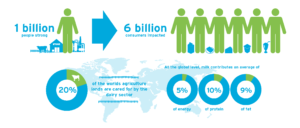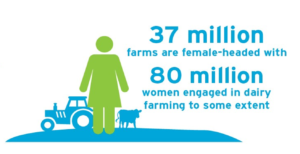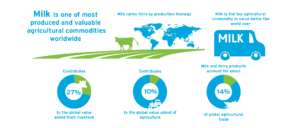The National Dairy Farmers Assuring Responsible Management (FARM) Program team offers an issues update for the 2020 NMPF Virtual Town Hall.
Tag: farm labor
NMPF Virtual Town Hall: Government Relations Update
NMPF’s Government Relations team offers an issues update for the 2020 NMPF Virtual Town Hall.
Dairy Farmers Elated at Homeland Security’s Reaffirmation of Food and Agriculture as a Critical Industry
ARLINGTON, Va. – The National Milk Producers Federation, the largest organization of U.S. dairy farmers, applauded the Trump Administration’s explanation that the food and agriculture is a critical infrastructure industry in the wake of the coronavirus national emergency, a move that encourages state and local authorities to allow farms and the entire food-supply chain to continue operating as usual amid current and potential restrictions created to stem the spread of the virus.
“This declaration allows farmers to do what they do best – feed U.S. consumers – in a time of acute need and anxiety,” said Jim Mulhern, president and CEO of NMPF. “Agriculture is working around the clock to ensure timely delivery of safe, abundant food. That’s what farmers always do – but in a time of unprecedented public-health concern, a fully functioning food system is even more critical to national health and well-being.”
The administration’s designation of “essential critical infrastructure workforce” was announced today by the Department of Homeland Security. NMPF has been deeply involved with the federal government in food supply-chain discussions throughout the coronavirus crisis: Its senior vice president of regulatory and environmental affairs, Clay Detlefsen, is the private-sector chair of the Food and Agricultural Sector Coordinating Council, an industry-government collaboration set up after the Sept. 2001 terror attacks to share information between government agencies and private businesses.
The Homeland Security declaration reflects how effectively industry is working with government and how much that relationship has progressed in this crisis, Detlefsen said. “We’re witnessing incredible collaboration among the Department of Homeland Security, the U.S. Department of Agriculture, the U.S. Food and Drug Administration and other government agencies and all sectors of the food industry. That’s been crucial to keeping supply chains running during these crucial days for public health and confidence.
“These key partnerships are firing on all cylinders,” Detlefsen said. “Agriculture’s appropriate designation as a critical industry should bring relief to farm families who want to help their country as well as to consumers who now know the world’s greatest agricultural producers can meet their needs unimpeded.”
Note: Listen to this podcast for more on Detlefsen’s role in the crisis and his thoughts on government response.
NMPF Ready to Help Dairy Farmers Meet Coronavirus Challenges
In response to the continued spread of COVID-19 (the coronavirus) in the United States and the virus’s potential impact on domestic and international markets, National Milk Producers Federation President and CEO Jim Mulhern said the following:
“As the organization representing U.S. dairy farmers and the cooperatives they own, the National Milk Producers Federation stands ready to assist its members in addressing coronavirus challenges. From possible damages to domestic and world markets, to supply chain labor disruptions on the farm, at the processing plant or in transporting milk, the potential ramifications for dairy are wide-ranging. We will devote our resources to the best of our ability to helping dairy farmers and cooperatives respond to whatever challenges they may face.
“The good news is that the U.S. dairy supply is safe, and production of high-quality products continues unimpeded. The FDA has confirmed that heat treatment kills other coronaviruses, so pasteurization is expected to also inactivate this virus. In addition, there is no evidence that this strain of coronavirus is present in domestic livestock such as cattle.
“Still, all producers will remain vigilant as what has now been labeled a pandemic continues its path. We will continue to answer questions and offer information to help our members. Policy solutions also may be needed for producers whose operations have been affected by the virus. In keeping with our mission of serving our members, regardless of the challenge, we will work with lawmakers and regulators to ensure a safe and adequate supply of milk and to mitigate potential economic harm to dairy farmers.”
NMPF’s Bleiberg on Senate Ag-Labor Efforts
NMPF’s vice president for government relations, Paul Bleiberg, discusses the potential for a Senate agricultural labor bill this year — and NMPF’s member fly-in to discuss the issue with individual Senators — on the Adams on Agriculture podcast.
Working to Improve Dairy Labor, Inside and Outside Washington
As the voice of dairy farmers in Washington, the National Milk Producers Federation constantly works for policy solutions to help our members succeed. As an organization that advances the interests of dairy farmers and the cooperatives they own, we strive to help producers meet their evolving needs regardless of the prevailing policy environment in Washington. Our ongoing efforts to improve dairy’s labor situation are a clear example of both priorities at work.
Agricultural labor reform legislation is a top Washington priority for us in 2020. We’re doing all we can to advance the policy process even though it’s a contentious election year. We’re also building the new FARM Workforce Development program, which will give farmers tools to better manage their workforce needs in the here and now. One effort aims to create a reliable ag worker program that would alleviate labor shortages and allow for future growth; the other focuses on human resources and safety management to ensure the highest quality dairy workforce here and now. The dual approach embodies NMPF’s comprehensive, farmer-driven problem-solving.
About farm-labor legislation: We celebrated a win last December when the House of Representatives passed its first ag-labor bill since 1986. The initiative created a workable guest-worker program for year-round agricultural sectors, including dairy, and offered a vehicle that can be improved and reconciled with any bill on this topic the Senate passes this year. But of course, key to that strategy is actual Senate passage – and on that front we are working diligently to pave a way forward.
We’re anticipating a Senate bill will be introduced this spring containing changes to the H-2A visa program so it can work for dairy – and stabilization of our current workforce. Observers of behind-the-scenes negotiations expect that the Republican-led Senate will likely make improvements to H2A that build on the House’s initial effort. Indications are that USDA is working to keep ag labor reform on the agenda and that the White House has spoken with Republican senators on this topic, suggesting that a compromise is still possible.
Any Senate bill would likely need to be considered before Congress leaves for its summer recess to have a chance to be reconciled with the House legislation in time for final congressional approval this year. We’re making sure dairy’s voice is heard throughout the process – including by having a large group of our dairy advocates from across the country make Capitol Hill visits this month to talk with their Senators. Ag labor reform is crucial for future prosperity. This potential opportunity isn’t one we can afford to let pass by.
But working for improvements in Washington isn’t enough to help farmers navigating an increasingly complex labor market on their own farms every day. That’s where FARM Workforce Development (WFD) comes in. FARM is developing a guide to best practices that offers assistance, not requirements — designed to help farms improve their HR and safety management; identify which best practices will be most useful to implement on their farm; and track improvement over time.
The WFD program area as a whole is focused on farm-level best-practices. And by helping farmers better lead their workforces, it also provides important assurances to dairy customers, an increasingly important consideration in a consumer conscious age.
A WFD evaluation tool was tested in a pilot program involving 10 cooperatives and 28 dairies that provided feedback, ranging in size from 120 cows to 18,000. We also solicited public comments on the tool. Overall response to the tool was positive and constructive, and the tool itself will be discussed and presented for approval at National Milk’s Board meeting later this month. FARM Workforce Development may not generate the headlines of immigration legislation, but it is very important – because farmers won’t prosper tomorrow if they don’t thrive in the here and now.
That is, after all, what we are striving to do. There may be no more emotional or complex an issue in dairy today than labor markets. But that’s exactly why engagement is so crucial. Farmer concerns spur action – and progress – inside the Beltway and far beyond it. It’s all how we serve our members, and our commitment will not waver.
Dairy Defined: Be Thankful for Dairy’s Global Success This Christmas
ARLINGTON, Va. – Despite the seasonal pressures to buy, buy, and buy, the holidays are best as a season for giving. Yes, that means solicitations – deserving charities fill mailboxes, and earnest pleas to remember the less fortunate have become staples of the holiday season.
But for many people in less-wealthy parts of the world, the property for which they can be most thankful is something people in rich nations take for granted: Dairy cows. For all the disparagement it receives in some, more affluent quarters, the fact is that dairy provides livelihoods and nutrition to hundreds of millions of people, many of them poorer, worldwide. Dairy lifts people from poverty and protects them from hunger. Dairy gives women jobs and sends girls to school. Dairy supports ecosystems and connects farmers to markets.
Stepping outside first-world problems for a moment, here for the holidays are a few thoughts on dairy’s global reach, and why we should be thankful for dairy farmers worldwide. (Thank you to Global Dairy Platform, an industry partnership that demonstrates dairy’s contribution to global food systems, healthy diets and sustainable livelihoods, for sharing data and graphics.)
- The world is home to about 133 million dairy farms, with about 600 million people living on those farms. Another 400 million additional people work full-time jobs throughout dairy’s value chain That means more than roughly 1 in 8 people on the planet – 1 billion – are economically supported by dairy.

- Most developing-world dairy farms have herds of two or three cows. Farms with more than 100 cows represent less than 0.3 percent of all dairy farms worldwide.
- Of those 133 million dairy farms, 37 million of them are run by women.

- Milk and dairy products account for about 14 percent of all global agricultural trade.

- Finally, dairy is continually becoming more climate-efficient; greenhouse gas emissions have dropped by 11 percent per unit in the past decade. In North America the declines have been even steeper, falling not just per unit, but in total gross emissions as well.
Dairy is a big deal globally, just as it is in the United States. But dairy looks different in developing countries. It looks more basic, like something that’s essential to simple survival. Like something that should be nurtured and supported as a basic human right.
So when rich-world advocates call for sweeping changes to global diets or eliminating entire agricultural sectors — even though such goals could be met in ways that would allow agriculture to thrive, reduce poverty and contribute to climate and nutrition solutions — keep that in mind. This isn’t only about the 40,000 U.S. dairy farms that are the most carbon-efficient in the world. It’s about 133 million farms and a billion people, many who have much more to worry about than whether their beverage choices signal virtue to their privileged friends.
Let’s be thankful that dairy benefits everyone, regardless of their circumstances or wealth. Let’s work to encourage and sustain its success and celebrate its many contributions to our health and prosperity this Christmas season. Happy holidays, and a happy new year for dairy.
(Note: NMPF’s Dairy Defined explores today’s dairy farms and industry using high-quality data and podcast interviews to explain current dairy issues and dispel myths.)
NMPF’s Bjerga Discusses Ag-Labor Bill and the Senate
NMPF’s Bleiberg Discusses Agriculture Labor Bill
Paul Bleiberg, NMPF’s vice president for government affairs, talks about the new agriculture labor bill before the House of Representatives on the Adams on Agriculture podcast.
Dairy Defined Podcast: Mooney Speaks at Annual Meeting
(Note: NMPF’s Dairy Defined podcast explores today’s dairy farms and industry using high-quality data and podcast-style interviews to explain current dairy issues and dispel myths.)
ARLINGTON, Va. – U.S. dairy farmers have been through challenging times, but they’re ready to face the challenges of trade, the environment, climate and changing consumer tastes, said Randy Mooney, a Missouri dairy farmer and chairman of the National Milk Producers Federation. Mooney spoke this morning at the organization’s annual meeting, this in New Orleans.
“Dairy farmers play an important role in society. We help preserve communities,” he said. “Like all of you, I’m proud to be a dairy farmer, producing the most nutritious product in the world.”
To listen to the full podcast, click here. You can also find the Dairy Defined podcast on Spotify and SoundCloud. Broadcast outlets may use the MP3 file. Please attribute information to NMPF.
###
The National Milk Producers Federation (NMPF), based in Arlington, VA, develops and carries out policies that advance dairy producers and the cooperatives they own. NMPF’s member cooperatives produce more than two-thirds of U.S. milk, making NMPF dairy’s voice on Capitol Hill and with government agencies. For more, visit www.nmpf.org.
NMPF’s Bleiberg on Immigration Bill
NMPF’s Vice President for Government Relations, Paul Bleiberg, discusses the recently introduced House immigration bill on the Adams on Agriculture podcast.
FARM Program Announces New Educational Resources
The National Dairy Farmers Assuring Responsible Management Program has released two new manuals and other materials as part of its FARM Workforce Development program area.
The FARM Safety Reference Manual provides straightforward, relevant and useful information on workplace safety and health meant to help dairy owners and employees develop and implement a robust and practical safety program. The FARM Safety Reference Manual is a collaboration between the Idaho Dairymen’s Association, the Idaho Milk Processors Association, and National Milk Producers Federation.
The FARM Human Resources Reference Manual helps dairy farm owners, managers and other relevant staff develop an on-farm HR program. An effective HR program supports a positive and safe work environment that helps attract and retain a professional, high-quality, and engaged workforce. A downloaded, customizable set of HR templates and a sample Employee Handbook accompany the FARM HR Manual. The manuals can be found here. Spanish-language versions of the manuals and templates will be available soon.
The National Dairy FARM Program launched its newest component last year, gathering expert and stakeholder input from the entire dairy value chain, including farmers, cooperative staff, academics, and other subject matter experts. This input ensures the Workforce Development materials are technically robust and relevant to today’s dairy industry.
With the manuals complete, the FARM Workforce Development Task Force met on April 8 to discuss future program priorities:
- Conduct a nationwide labor survey, implemented and analyzed by an academic institution. All data will be anonymous. The survey will provide robust, credible data to prove dairy’s labor story, especially in the face of misconceptions that exist outside of our industry.
- Develop additional resources to support dairy producers, such as training videos and a safety ‘road map’. A breakout session at the Dairy Sustainability Forum in early May provided additional ideas and direction for useful resources.
- Pilot an on-farm evaluation tool to help farms learn about HR and safety management best practices; identify which practices might be useful for their farm; and, track improvement over time. By performing on-farm evaluations, the industry can also provide important assurances to dairy customers, retailers, and brands.
FARM Workforce Development demonstrates that the U.S. dairy industry is proactive and passionate about providing safe and thriving work environments.






